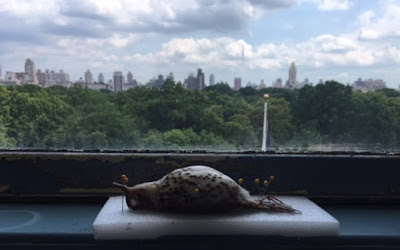Week Five: Comparing Collections - Two Birds One Fossil
Hello again!
Week number five has come and gone and we’re well on our way
to complete our goal of thirty cabinets of rehoused, cataloged and databased
specimens. We’ve worked our way through all the recent nautilus collections and
are back to working with (mostly) Carboniferous fossil cephalopod specimens.
Cabinets housing fossil specimens, we’ve noted, are far more time consuming to
curate than cabinets of nautilus shells so we still have much work ahead of us!
 |
| ©AMNH/N. Berlet |

We met Paul at his office (which had a fantastic view of Central
Park) where he proceeded to explain that the museum houses one of the largest
collections of bird specimens in the world with about one million specimens
(including study skins, skeletons, ‘pickles’, eggs, nests, and tissue samples)
on multiple floors. He proceeded to show us the vast, not to mention colorful, bird collections. (Note the unnerving, and probably haunted, manual elevator.)

Notably, Paul stated that the entire ornithology collection has been completely digitized after years and years of work. This bit, for me, helped bridge the gap between the work done in the ornithology collection and the work being done in the Mapes collection by us interns. Though we interns deal primarily with long extinct fossil specimens, our general goals are pretty much the same as Paul with his (relatively) recent birds.


Whether the specimen is a recent hummingbird study skin or an extinct ammonite fossil, our shared goal is to conserve and curate the specimen itself. We seek to house, catalog, and database specimens to get the most potential scientific value out of them for as long as possible. Just as species go extinct, collections too have a lifespan – as time passes specimens can deteriorate (by pyrite disease, housing conditions, pests, water/fire damage, etc.) and associated information can physically degrade or be lost. In order to long-term conserve scientifically valuable collections, such as the Mapes, for future research we rehouse specimens in a controlled environment using archival material. Further, we capture associated information into databases both to have a digital record and also to make this data more accessible and searchable.
A testament to the conservation aspect of collection work, Paul showed us, are the almost 200 year old bird study skins collected during the early 1800s. It’s astounding that bird specimens can be preserved for such a long period of time and still be in such good shape (my own personal astonishment probably stems from exclusively working with fossil invertebrates).


The importance of the work being done in museum collections was further solidified when Paul showed us specimens of recently extinct species due to human activity. These specimens are irreplaceable and invaluable considering it’s all we have left of these species. To fail to properly conserve and curate these specimens would be a great scientific loss second only to the extinction itself.
We'd like to thank Paul for giving us a great tour and a deeper appreciation for ornithology and collection work in general. And on a lighter note, the quiches served in the employee
cafeteria this week were pretty incredible.
Until next week,
Ernesto and the rest of the interns.

















Comments
Post a Comment